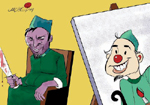 Mainstream Bangla films and theatre plays on Liberation War represent mostly depict collaborators of the occupational Pakistani Army as clowns in typical attires. In most of such films and theatre productions, collaborators appear as fictitious comical characters with attires of pajama, punjabi and tupi, and with make-up of clownish bearded man, who are engaged with some trivial activities such as handing over women to the Pakistani army and burning houses.
Mainstream Bangla films and theatre plays on Liberation War represent mostly depict collaborators of the occupational Pakistani Army as clowns in typical attires. In most of such films and theatre productions, collaborators appear as fictitious comical characters with attires of pajama, punjabi and tupi, and with make-up of clownish bearded man, who are engaged with some trivial activities such as handing over women to the Pakistani army and burning houses.
The cruelty of razakar, Al Bad’r or Al Shams during the war in 1971 is completely missing in the portrayal of the collaborator characters in the films and theatre productions, though they were directly involved with crimes against unarmed people during the war.
Unrealistic depiction of such horrific scenes in films and theatres sometimes generate laughter among the audience, which not only distort history but also humiliates the victims of atrocities perpetrated by the collaborators, observe renowned critics and directors.
They observe that lack of knowledge and research is the main reason behind the typical portrayal of razakars in the rural setting. Such productions hardly represents massacres done by the war criminals in the cities, though it is a historical fact that many educated youth joined the militia groups in the support of the Pakistani army and reportedly killed and raped the people of this land, they said.
Renowned film critic Anupam Hayat said, ‘The directors try to portray razakars in a simplistic way and do not feel inclined to do research required for such works.’
‘When the western people made hundreds of films on Hitler, we have not seen any such film on any of the prominent collaborators in Bangladesh,’ he said.
Film activists and filmmakers admit that they made films on the war in the rural settings as war mostly took place in the rural areas and it is also easy to make films in the rural settings.
Filmmaker Tanvir Mokammel, who made several films on the war, explains the logic of the stereotypical presenting collaborators in the Bangla films saying that most of the collaborators of the auxiliary force of the Pakistani army were from lower echelon of the society. ‘There may be some stereotyping in the portrayal of the razakars as uncouth and uneducated in Bangladesh cinema, but it was not something wrong, as most of them were actually like that.’
‘Sophisticated ones were few and far between. Muslim outfit was natural for them as they were also very keen to show off their Muslim identity,’ Mokammel said.
‘It is the fact that most of the razakars pictured in films are typical in terms of their dress-up and gestures,’ said noted filmmaker Kazi Hayat, adding that some filmmakers like him authentically presented massacres carried out by razakars in films.
‘Authentic depiction of Dhaka in 1971 is really tough,’ said film activist and director Shah Alam Kiron, whose film on the war Ekatturer Maa Jannani will be released on December 19.
Noted theatre director Ahmed Iqbal Haider admits the allegation saying, ‘The well known razakars have not been featured in theatres and it is because they have become so powerful after the independence.’
‘I would say it shouldn’t have happened like that; it just became a popular trend among the theatre organisers to present razakars in that way.’ Haider, who is the director of independence war-based plays Boma and Smrity 71, also said a change must be brought in the situation.
Bangladesh Group Theatre Federation chairman and theatre director Liaquat Ali Lucky said the trend of portraying razakars in theatre productions had started just after the War of Independence and it became common in war-based plays in the mid-1980s.
‘Many street theatre productions on the war had been staged during the period portraying razakars as clowns. It was done partly to attract viewers of street theatre productions and partly anticipating possible danger of depicting razakars’ massacre in the era of military dictatorship,’ Lucky said, adding that he directed a play, Royal Begal Tiger, depicting war criminal Golam Azam as the antagonist.
Lucky said Bangladesh Group Theatre Federation took a new programme to patronise more theatre productions on the War of Independence. ‘We will instruct the directors and playwrights to produce theatre on the well known war criminals,’ he said
Meanwhile, critics observe that the directors must do required research before presenting the films and theatre productions on different types of real life characters as these productions will represent history to the future generation.
-With New Age input




















